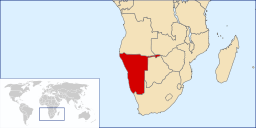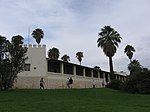Context and Beginnings
This section briefly describes the educational context in Namibia and an important precursor: insect@thon - a project of Namibia's National Museum's Biodiversity Inventory Programme to computerise records of insect collections in collaboration with schools.
About Namibia
| Wikipedia on Namibia
Namibia has a population of 2.1 million people and a stable multi-party parliamentary democracy. Agriculture, herding, tourism and mining of precious stones and metals form the backbone of Namibia's economy. It is the second least densely populated country in the world, after Mongolia. Approximately half the population live below the international poverty line, and the nation has suffered heavily from the effects of HIV/AIDS, with 15% of the adult population infected with HIV in 2007. http://en.wikipedia.org/wiki/Namibia (20/9/10)
|
The Republic of Namibia is located on the West coast of southern Africa bordering on Angola in the north, South Africa in the south, Botswana in the East and touching Zimbabwe and Zambia in the north-east.
Namibia's Wikipedia article is a good place to start for contextual and background information. However, it should be noted that Namibia is not regarded as typical of sub-Saharan Africa in terms of education and its ICT infrastructure. It is generally considered to be ahead of the pack[1],[2]. Nevertheless, the following quotes indicate some of the challenges typical in Namibia (& elsewhere in Africa):
This is one of the more affluent schools in northern Namibia and currently the school cannot provide the learners with adequate textbooks, desks, and chairs. (Kathy Anne Chaffe, 2004)[3])

The Republic of Namibia has a population of approximately two million made up of 13 ethnic cultures and 16 language groups. Although Gross National Product (GNP) is relatively high, the country has inequalities in income that are among the highest in the world. Namibia has significant natural resources, but the potential for development is held back by a low skills base that hampers foreign investment. The Education and Training Sector Improvement Programme[4] is aimed at improving the education and training system to support the achievement of development goals. (Rumble and Koul, 2007)[5].Development goals are articulated in Vision 2030[6] a national plan to ”improve the quality of life of the people of Namibia to the level of their counterparts in the developed world by 2030”. Vision 2030 identifies “education, science and technology” as one of its priority areas for improvement. The activities of SchoolNet Namibia contributed primarily in this area. The others are health and development, sustaining agriculture, peace and social justice, and gender equality.
Entities and Initiatives
The following are significant players in the ICT and education sectors in Namibia with a baring on SchoolNet's activities.
- The Education and Training Sector Improvement Programme (ETSIP)[7]: a fifteen-year strategic plan (2006 -2020) developed by the Namibian education sector in response to the demands of Vision 2030.
- TECH/NA![8]: the Namibian ICTs in Education Initiative, “a holistic, end-to-end approach that provides a comprehensive solution for all educational institutions progressing towards the goals of Vision 2030”.
- Namibian Communications Commission (NCC)[9]: established under the Namibian Communications Commission Act, 1992 (Act 4 of 1992) to “issue broadcasting licenses, control or supervise certain broadcasting activities and program content, and to provide for matters incidental thereto”.
- Telecom Namibia[10]: “the national telecommunications operator, established in August 1992 and wholly owned by the Government of the Republic of Namibia”.
- ICT Alliance[11]: “a stake holder comprised organisation that is committed to the successful development, positive growth and ethical conduct of the Information and Communication Technology society in Namibia”.
- XNet Development Alliance Trust: a trust founded in 2003[12] by SchoolNet Namibia and Telecom Namibia to fund internet access for the commercially unfeasible development sector of Namibia. The Trust was to act for schools seeking internet access.
- National Institute for Educational Development (NIED)[13]: “a Directorate within the Ministry of Education with the continuous task of ensuring that education in Namibia is developed and improved in accordance with the latest developments in education and the needs of the people of Namibia”.
Precursor
SchoolNet Namibia grew out of Namibia's National Museum's Biodiversity Inventory Programme. The museum is the custodian of natural history collections of between 1 and 1.5 million specimens, most of which are insects. The programme sought to computerise 70,000 hand-written insect inventory records involving learners from schools around the country.
The project addressed the need for access to biodiversity information, but was also a reaction to the fact that many first world museums hold data on species collected in the developing world in a form (paper based records) that is not accessible to people in the countries in which the data was collected. For example, the Natural History Museum in London has some 65 million insects in its collections including records related to data collected in Namibia. At the time, it was estimated that as much as 70%[14],[15] of the data in these collections originated in the developing world. The message was "if we can do it, you can too!" (and you owe it to us).
The programme also constituted a community self-help exercise for Namibian schools providing opportunities for them to gain computer equipment, skills and internet access in exchange for community services at the National Museum of Namibia.
In mid-August 1999, a two-day "insect@thon" was convened by the museum in collaboration with leading local corporations in Namibia.
Using an innovative computer inventory application developed by staff of the National Museum, 92 learners from 16 schools participated. In 12.5 hours they managed to computerise 20,897 insect inventory records each with 11 data fields (catalogue number, order, family, genus, species, collection locality, collector, no. of specimens and day, month year) representing 97,696 specimens in the National Museum's insect collection.
Immediate post-event validation revealed an error rate of 13% (3,232 invalid records), which is not bad considering that 66 of the learners had never previously used a computer. The model clearly has merit for digitising environmental data with the limited resources available in most "developing" contexts. The model may be extended and adapted to cover (e.g.) trees (tree@thon), mammals (mammal@thon), etc., or any digitization exercise with mutual benefit for community organisations and community contributors.
In this case, the museum rallied the local corporate community for (socially responsible) support in the form of subsidised school internet and computerisation in exchange for these schools providing a data-entry pool at the museum. The learners gained experience of using computers for a useful purpose, and about environmental data collection and the relevance of museums.
Next steps included further validation of the data and establishing the insect@thon as an annual event. The following year, five regional events preceded a final insect@thon 2000 in which learners from 12 schools computerised 10,310 insect records representing 46,103 insect specimens, bringing the total for that year to 31,020 records (152,751 specimens)[16].
A first sub-goal towards further expansion would be to ICT-enable all of these engaged schools.
This became the goal of SchoolNet Namibia. The organisation was established as an “association not for gain” in February 2000[17] through strategic partnerships with the Ministry of Basic Education, Sport and Culture, tertiary institutions and the private sector. With this experience of community empowerment (with ICT) and cooperation between schools and community organisations, SchoolNet Namibia pioneered the use of free software in schools and a community based model for on-going support. Essential learning is shared in this case study as we tell the story of SchoolNet Namibia.
Sources
The material on this page under "Precursor" is adapted (slightly) from Africa Action which contains "excerpts from e-mail and web reports on a successful project by the National Museum of Namibia". Please help if you can find the original URLs - the museum's web address seems to have changed.
- ↑ See the information provided by Southern and Eastern Africa Consortium for Monitoring Educational Quality (SACMEQ). Start with Namibia: http://www.sacmeq.org/education-namibia.htm
- ↑ See also: Farrell, Glen; Isaacs, Shafika & Trucano, Michael (eds.). 2007. Survey of ICT and Education in Africa (Volume 2): 53 , Country Reports. Washington, DC: infoDev / World Bank. Available at http://www.infodev.org/en/Publication.354.html
- ↑ Kathy Anne Chaffe, PCV, Namibia, 2003-2004. http://schoolnet.edunet-namibia.org/projects/best/comparison.pdf (20/9/10)
- ↑ http://www.etsip.na/
- ↑ Rumble, G and Badri N. Koul. Open Schooling for Secondary & Higher Secondary Education: Costs and Effectiveness in India and Namibia. COL, 2007, http://www.col.org/resources/publications/consultancies/Pages/2007-07-openSchl.aspx
- ↑ http://www.npc.gov.na/vision/vision_2030bgd.htm
- ↑ http://www.etsip.na/about_us.php
- ↑ http://www.tech.na
- ↑ http://www.ncc.org.na/
- ↑ http://www.telecom.na/index.php/company/corporate-profile
- ↑ http://www.ictalliance.org.na/
- ↑ http://schoolnet.edunet-namibia.org//news/stories/xnetlaunch.html
- ↑ http://www.nied.edu.na and the quote from http://www.nied.edu.na/About-us/About-us.htm
- ↑ At the time (1999) The Academy of Sciences in California, the Natural History Museum in London and the Natural History Museum in Berlin were estimated to have about 800,000 Namibian insect specimens in their collections.
- ↑ See for example, the Global Biodiversity Facility as an attempt to address this issue: http://www.gbif.org.
- ↑ National Museums of Namibia - InsectAThon 2000, news item, 15/2/01, African Conservation Foundation, http://www.africanconservation.org/forum/news-archives-around-africa/487-national-museums-of-namibia-insectathon-2000.html
- ↑ A launch meeting was held November 1999 in Windhoek officiated by Permanent Secretary, MBESC and Managing Director, Telecom Namibia . The First General Meeting was in February 2000.
